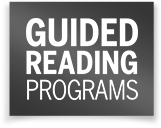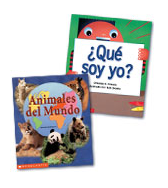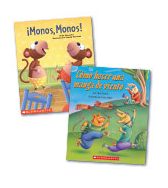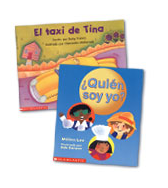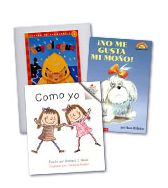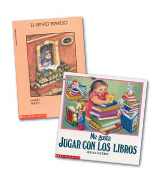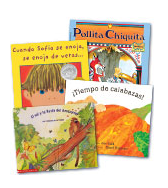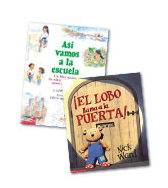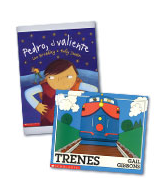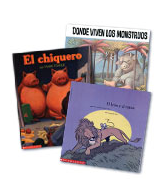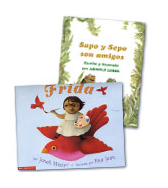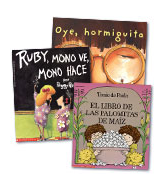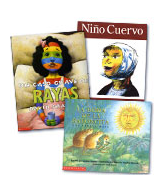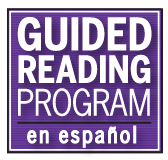Guided Readingen español
About Guided Reading en español
Research has proven that children with strong literacy skills in their first language are more readily able to acquire literacy skills in a second language. Guided Reading en español engages students in reading with carefully leveled literature in Spanish. Easy-to-follow teaching materials help you build students' language proficiency in Spanish and helps them make an easier transition into English.
- Authentic Spanish-language literature and favorite books sensitively translated into Spanish
- Bilingual Teaching Cards
- Teacher's Guide written by Dr. Gay Su Pinnell and leading bilingual educators
Teacher’s Guide
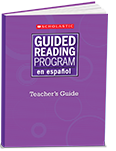
 Look Inside
Look Inside
Title List
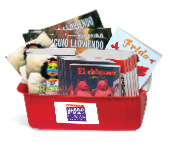
 Look Inside
Look Inside
Teaching Cards
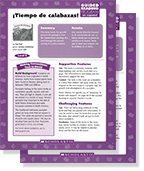
 Look Inside
Look Inside
en español Leveling Chart
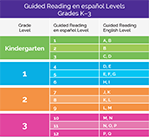
 Look Inside
Look Inside
Buy multiple-level grade sets and save even more!
COMPLETE SET (Grades K–3,
Levels 1–12)
Grade K–1 (3 levels, 1–3)
15 titles, 6 copies each, 90 books
Grade 1-2 (3 levels, 4–6)
15 titles, 6 copies each, 90 books
Guided Reading en español Reading Levels
Level 1
Picture books with simple labels or captions, and some with up to five or six words, often on one line. These texts have clear, easy-to-read print with generous space between words. These simple formats enable young children to focus on print and reading from left to right while gradually increasing their control over more words.

Level 1 Titles
- Un día de escuela — Cervantes
- Animales del mundo — Rodriguez
- ¿Qué soy yo? — Frizado
- Yo puedo correr — Pinnell
- 1,2 y 3 a la caja! — Tarlow
Level 2
Level 2 texts have simple story lines or a single idea. The print is easy-to-read with adequate space between words so that children can point to words as they read. Texts at this level generally have one or two lines of print on a page, somewhat longer sentences, and a variety of punctuation. There is some direct correspondence between the text and pictures, and repeating patterns support the reader. Topics are generally familiar to most children.

Level 2 Titles
- ¡Monos, Monos! — González
- ¿De quién son estos huesos? — Fernandez
- Nosotros vivimos aquí — Salzman
- El mitón — Tarlow
- Cómo hacer una manga de viento — Tarlow
Level 3
Level 3 texts have more words and lines of print than level 1 or level 2 texts. Print is clear and readable with adequate spaces between words. Most sentences are simple, but some have more complex structure, offering readers a challenge. Language patterns are more likely to change from page to page, so children cannot rely on them to make predictions and must pay closer attention to print.

Level 3 Titles
- ¿Quién soy yo? — Lee
- Yo veo los peces — Curry
- Por favor. Gracias. — Alexander
- El agua — Blevins
- El taxi de Tina — Franco
Level 4
Level 4 texts have topics that are familiar to most children but also include some abstract or unfamiliar ideas. Text layout is still easy to follow, with both large and small print. Sentences are longer and are carried over to the next page or several pages and use a full range of punctuation. There are more compound words, multisyllabic words, and words with a variety of inflectional endings. Illustrations are still supportive but less so than at the previous level requiring the reader to pay more attention to print.

Level 4 Titles
- ¿Qué hora es? — Moriarty
- Como yo — Neasi
- Soy el agua — Marzollo
- ¡No me gusta mi moño! — Wilhelm
- ¡Corre, perro, corre! — Eastman
Level 5
Texts are not repetitive. Level 5 texts include a variety of patterns. Knowledge of punctuation is important in understanding what the sentence means and how it should be spoken. Vocabulary is more challenging, with a greater range of words and more difficult words, including some that are technical and require content knowledge. Texts have a greater variety of styles of print and text layout, requiring close attention to print and flexibility on the part of the reader.

Level 5 Titles
- Los animales nos ayudan — Cherrington
- La semilla de zanahoria — Kraus
- Me gusta jugar con los libros — Santirso
- El viento travieso — Bradley
- Ellen Ochoa — Walker
Level 6
Texts are similar in difficulty to level 5 but have a wider variety, including texts with poetic or literary language. Sentences vary in length and difficulty, and some complex sentences carry over several pages. Texts have fewer repeating events and language patterns. Vocabulary is expanded and includes words that are less frequently used in oral language. Size of print varies widely.

Level 6 Titles
- Tiempo de calabazas — Hall
- Pollita Chiquita — Zimmerman
- Y siguió lloviendo — Shannon
- Cuando Sofía se enoja, se enoja de veras... — Bang
- El sol y la lluvia del Amazonas — de la Piedra
Level 7
Texts are longer and more complex than at levels 5 and 6. Size of print is smaller, and there are more lines of print on the page. Texts have longer sentences and paragraphs. There are more multisyllabic words. Illustrations enhance the story but provide low support for understanding meaning.

Level 7 Titles
- ¡El lobo llama a la puerta! — Ward
- Siete ratones ciegos — Young
- Así vamos a la escuela — Baer
- Gilberto y el viento — Hall Ets
- Sombras — Otto
Level 8
Texts are more difficult and varied than level 7. Informational texts with new concepts and chapter texts with complex narratives and memorable characters can be found in this level. Illustrations enhance the text but offer little support for figuring out new words. Texts have many high frequency words but may also have unfamiliar and/or technical words.

Level 8 Titles
- Plantas que comen animales — Fowler
- Perros de trineo — Todd
- Pedro, el valiente — Broadley
- Trenes — Gibbons
- Clic, Clac, Muu: vacas escritoras — Cronin
Level 9
Level 9 includes longer chapter texts, shorter informational texts, and literary texts with illustrations that enhance meaning. Stories have multiple episodes related to a single plot. Some stories have to do with times, places, and characters outside children’s experience.

Level 9 Titles
- El chiquero — Teague
- El león y el ratón — Valeri
- Los murciélagos — Goldberger
- Querido Salvatierra —
- Donde viven los monstruos — Sendak
Level 10
At Level 10 there is a variety of texts, including informational texts, biographies, chapter books, and some longer, highly literary, or informational picture books. Chapter books have more sophisticated plots and characters that are developed throughout the text. Some texts have abstract or symbolic themes that require higher-level conceptual understanding. Texts contain an expanded vocabulary with many multisyllabic words.

Level 10 Titles
- Sapo y Sepo son amigos — Lobel
- Avenida Pennsylvania No. 1600 — Wirth
- Una canasta de cumpleaños para Tía — Mora
- Los bomberos — Mitten
- Frida — Winter
Level 11
Texts have a variety of formats. Topics vary widely and include subjects that will be familiar to children and those that are new. Literary selections have complex language and subtle meanings that require interpretation and background knowledge. Chapter books are longer with few pictures.

Level 11 Titles
- Ruby, mono ve, mono hace — Rathmann
- Oye, hormiguita — Hoose & Hoose
- Las llamas — Ring
- Tikki Tikki Tembo — Mosel
- El libro de las palomitas de maíz — de Paola
Level 12
Longer texts in a variety of genres. Chapter books present memorable characters developed through literary devices such as humor, irony, and whimsy. Informational texts offer mystery and suspense. Vocabulary continues to expand, and topics go well beyond students’ own experiences.

Level 12 Titles
- ¡Relámpagos! — Hopping
- Un caso grave de rayas — Shannon
- El secreto de las momias — Goldish
- Niño Cuervo — Yashima
- La boda de la ratoncita — Dupré
